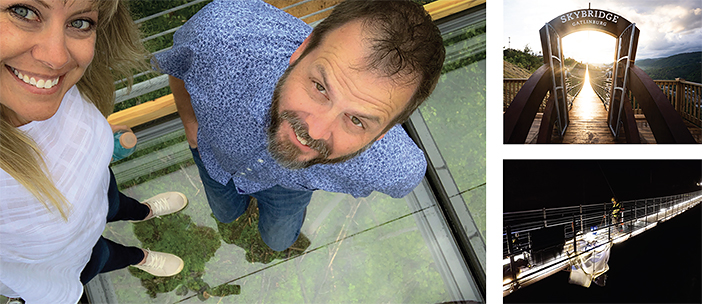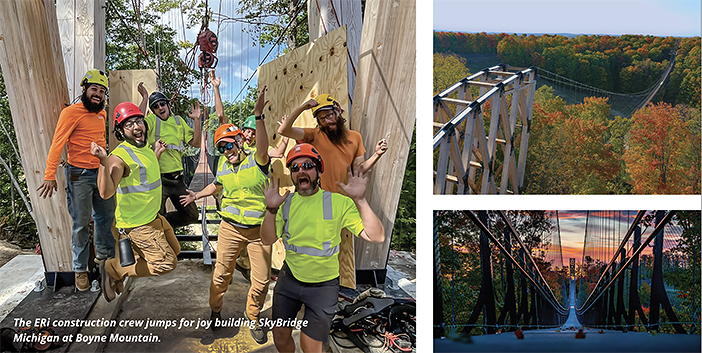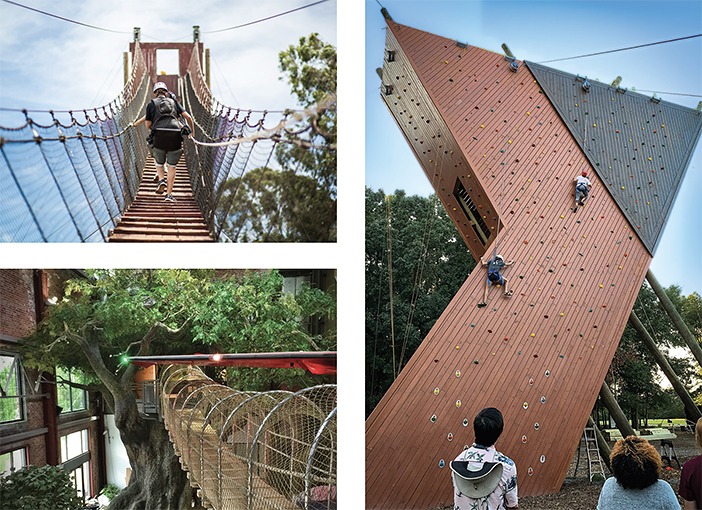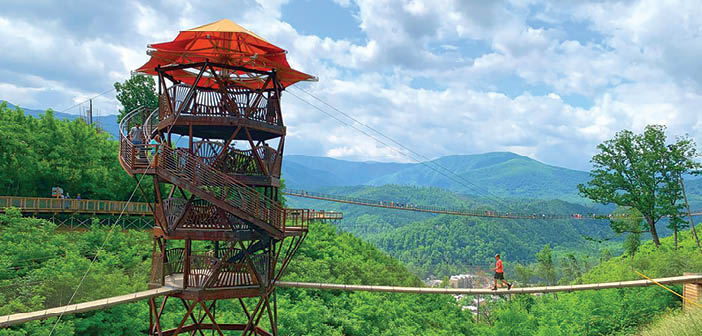Experiential Resources Inc. (ERi) has become one of the most well-known companies in the adventure park business, thanks to its knack for building innovative attractions that spark the imagination of the public. Founded in 1993, with a long history of building and managing zip lines, ropes courses, and adventure parks, ERi has turned a more recent specialty—building suspension bridges of eye-popping dimensions—into headlines and media appearances.
Signature projects have included the 680-foot Gatlinburg SkyBridge, built in 2019 and then the longest pedestrian suspension bridge in North America; and the new SkyBridge Michigan at Boyne Mountain, a 1,000-foot span connecting two mountain peaks—now the longest timber-towered suspension bridge in the world.
API recently talked with Maui-based ERi chief designer and owner Todd Domeck, and the company’s CEO and co-owner, Washington state-based Mandy Stewart, about the company’s evolution, finding a niche, and where one of their bridges might be hanging next.

Left: Mandy Stewart and Todd Domeck. Right: The iconic entrance to Gatlinburg SkyBridge, and construction on the SkyBridge after dark.
API: Todd, you bought this company when you were 25 years old. How did you get into this industry?
Todd Domeck: I grew up in Kentucky and started rock climbing at a pretty young age. I saw Top Gun and wanted to be a fighter pilot at 12 years old, and that led me to study math, science, and engineering.
I interned at an engineering firm that, ironically, was building bridges. When I asked the engineers, “When do we go see the bridge?” they laughed at me and said, “We’re engineers, we’re not builders. We never go see the bridge.” That was disappointing … so, I quit engineering school and finished at Eastern Kentucky University.
While I was there, I took a job working for a Girl Scout camp outside of Nashville as the ropes course director. I’d never been on a ropes course, but I was 20 years old, I can do anything, right?
Fast forward with ERi … now, we’ve got a client base that asks us to just be inventive and imaginative, and then we come up with ideas and sometimes they buy them. Career-wise, I’m right where I want to be because I’m not bidding on other people’s designs or building other people’s designs. Everything that we’re putting out is 100 percent from us, and we want to keep doing that.
API: Mandy, you’ve had an interesting journey from ropes course guide to company CEO. Tell us about that.
Mandy Stewart: The program I worked at was experiential education-based and was a wonderful program and facility, and I stayed there for quite a number of years. Then I moved across the country, to Washington state. Todd and I had known each other for years, and he was looking for someone to help out with a special project. He kind of poached me a little bit, and I started working for ERi. A couple years later, Todd apparently was happy with not having to handle all the details of managing the business and said, “I want you to run the company.”
API: What did you find captivating about the adventure park industry?
Mandy: Growing up, Indiana Jones was my hero and role model. So, there’s that aspect of it.
API: Did you come into it with a sports background or an outdoors background?
Mandy: I wasn’t a rock climber like a lot of people seem to be in our industry—just an outdoor enthusiast and experiential educator who accidentally landed on a challenge course in the early 2000s and loved it.

At 1,000 feet long, SkyBridge Michigan is “the longest timber-towered suspension bridge in the world.”
API: So, you learned on the job?
Mandy: A lot of it. I could list off a whole bunch of stuff that I’ve learned, but there’s always something new. My role hasn’t been a hands-on, turning a wrench sort of the thing. A lot of the things that I’ve been responsible for have to do with the management and compliance side.
API: That’s important, obviously, in this industry in particular.
Mandy: You have to make sure that you’re meeting standards, that you’re meeting your own company’s internal controls. When everybody’s happy with what they’re producing, and proud of the job that they’re doing, they’ll be safe, too. The sleep-at-night factor is huge for us.
API: Todd, ERi was kind of your baby for a long time, and then you bring Mandy in to be your CEO and be a partner. How did that transpire, and what makes it work?
Todd: I like designing things that last; what I don’t like doing is getting into the nitty-gritty, the compliance, the details for building permits, all that kind of stuff. Mandy handles all that well.
I live very far away from most of our projects—thousands of miles, and I also have two little kids. Mandy is able to do a lot of the stuff that I would do on the road: go out and check on projects and understand the scope of what’s happening and what’s not happening.
API: Mandy, why do you and Todd work so well together?
Mandy: Because our brains work so differently.
API: Todd, you’ve created products, built zip lines, and also run parks. You’ve worn a whole bunch of hats, but which one fits best?
Todd: I like bringing people together. I like designing or operating something that makes people have one of the best days of their life.
API: How has your approach changed since you first started?
Todd: In my early career, if someone said, “hey, come out and put a zip line in a pineapple field,” I would have gotten on the plane. Now, the way I look at it is: is it genuine? Is it authentic? I’m not just going to do it for the money. Another ropes course in a Walmart parking lot, in the middle of nowhere, doesn’t appeal to us.

Clockwise: The Tulip Tower at Gatlinburg SkyPark; the launch tower at Harborwalk Adventures in Destin, Fla.; Harborwalk Adventures lit up at night.
API: Your tag line is, “We build the cool stuff.” Some of that is top secret, so of course we want to hear about that.
Todd: Did you watch the Artemis launch? [Ed. note: In November, NASA launched an unmanned mission of a new spacecraft, Artemis, designed to take humans back to the moon.] The folks at NASA asked us to reimagine a system to rescue the astronauts in the event of a fire on the launch tower. We didn’t win the contract, but that’s still pretty cool.
It’s a little counterintuitive, but the ones that are difficult to figure out tend to be my favorites, because once we figure them out it’s a lot more rewarding. We built a climbing structure in the shape of the YMCA logo (see opposite page). We designed it, engineered it, and built it on the ground. It was 70,000 pounds, all made out of wood, and we had to stand it up all at once. That one was just really cool, a great couple of days of problem solving and working 12 hours a day. It made me feel young again.
The Gatlinburg SkyBridge, we’re very proud of it. We wanted to make the entrance to it a spot where people would stop and take their picture and it would be iconic. And people would know that, you know, when you’re scrolling through, they would know where you were by looking at the shape of the thing (see opening page).
Mandy: The main drag in Gatlinburg is busy—there’s a ton to do, a ton of restaurants. But you ride the chairlift up to the SkyCenter, go across the bridge to the west side, and you’re just up in the wilderness, looking out across the Great Smoky Mountains.
What I like about the bridge is that people are able to adjust their experiences to what they want to be doing, whether that’s sitting on the deck at the cafe or crossing the bridge more than 100 feet up in the air, but they can still have those experiences together as a family. That is really cool.
API: Tell us about the evolution of the company from building ropes courses to now where you’ve found this niche in building bridges.
Todd: Every element in a ropes course is a bridge, in a way; a zip line is a bridge, when you think about it. So, we make the joke that we’ve always been building bridges, they were just more difficult to cross.
Clients would ask us to build 30-, 40-foot bridges to access activities. Then they started to ask us to build bigger and bigger bridges. So, we built the two longest suspension bridges in Hawaii, but they were part of a zip line.
In Gatlinburg, they had us out there and said, “here’s a piece of property, what can you do with it?” We came up with like four or five things, and one was a 700-foot suspension bridge that will hold 500 people. That was our first big commercial bridge, which opened in 2019; we’ve now done 10-15 others. We had done bridges in the 200-300-foot range before that, but nobody really knew about them—they’re just part of another attraction.

Top: A bridge at Pi’iholo Ranch Zipline in Maui. Bottom: An indoor bridge at Milliken Outdoor Adventure Center, Mich. Right: The Big Buzz Y-Tower, designed and built for YMCA Camp Widjiwagan, Tenn.
API: How do you make a bridge an attraction in and of itself?
Mandy: It’s so adaptable to so many different people and what they’re looking for; it’s challenge and adventure, the same as all the other things we’ve been building for years. There are some people who would never ever do anything like zip lining, but they’ll step on a bridge. There’s another person who might go on a zip line but be totally freaked out on this long suspension bridge.
Todd: Even though these bridges are very expensive, they pay for themselves pretty quickly. So, it’s exciting to us that people are seeking out this bridge-walking opportunity.
I still don’t think you can put a bridge in the middle of a parking lot; there needs to be something that you can see and experience on the bridge that you can’t on the ground or from another place. If you build a two-foot-wide bridge, it might work as a walking path, but people can’t stand beside each other and talk to each other and talk about what they’re feeling.
When you get 500 people on one attraction and they’re literally walking beside each other, it does all the stuff that we as ropes course facilitators did in our younger days. As a facilitator, you have to design these experiences and take the group on this journey, and it’s going to take several days to get them to open up and talk to each other. Here, you’ve got a bunch of people who are complete strangers doing just that on a bridge, and it happens almost instantly.
Mandy: They’re reaching out to complete strangers with compassion and shared experiences and joy. It’s a really cool thing to just stand out there and watch people be so welcoming, so inclusive, so supportive, and also just happy and enjoying their shared experience.
API: Do you have a dream location where you’d love to build a bridge?
Todd: I’d love to have one in Hawaii and have it support the movement here to reclaim waterways and valleys where Native Hawaiians used to live and work. Something that could generate revenue as a tourist attraction to support a cause that’s really important.
API: Is there technology that has allowed you to do stuff that you wouldn’t have been able to do 20 or 30 years ago?
Todd: I wouldn’t say it’s physical; steel is steel, wood is wood, and cable is still cable. But AutoCAD, the software technology, is what’s made these things more predictable and safer. We can model out a complete bridge and do wind analysis, earthquake analysis. The Michigan bridge is a very good example. It was built on the ground and then lifted into place. Technology allowed us to keep our entire team on the ground, making it a much lower risk environment, and we could be confident that we could do it that way because we could model it.
API: Do you worry about being pigeon-holed as a bridge company rather than an adventure park company?
Todd: We joke that we’ve been pigeon-holed into building cool stuff. There’s always been some unique thing we’ve been doing. The Tango Tower was our first design; now we license those to other builders, and there’s been nearly 100 built. We don’t want it to be boring.
I don’t know what’s next after bridges. At this point, we are getting a lot of recognition for the bridges, but we do maintain a good set of traditional challenge course clients. We still have the professional services where we go out and we inspect, train, and maintain; we do that part because we love it. Just because it might not be the thing that’s showing up in the magazine or on the news doesn’t mean that it’s not still there.
API: We’re at the point in this industry where companies like yours are really starting to specialize—not everybody’s a jack-of-all-trades anymore. When you look at the state of this industry in 2023, what do you see?
Mandy: I think we need to create experiences that really make a difference in people’s lives. All these things that we carried forward from camp and educational environments, we want to see those roots stay strong.






